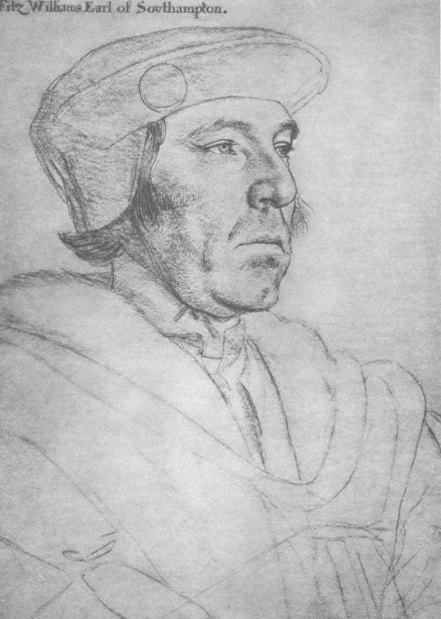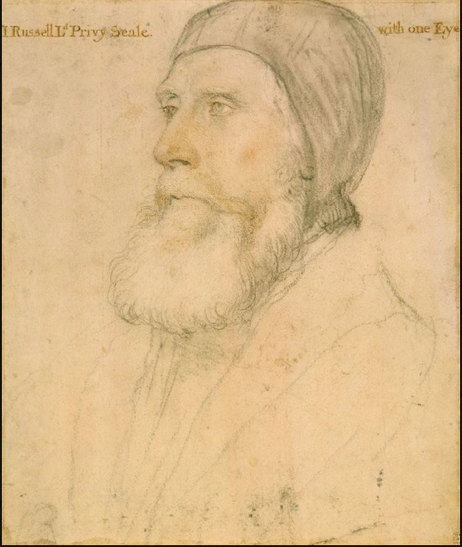October

Hans Holbein the younger (1497/8 - 1543)
Unknown Man with Lute
Berlin, Gemäldegalerie
HOLBEIN’S
UNKNOWN MAN WITH LUTE
It seems not to have been noticed that the gold ornament which the sitter wears round his neck in Holbein’s portrait: Unknown Man with Lute [Berlin, Staatliche Museen, Gemäldegalerie] is in fact a boatswain’s call. And, unlikely as this may seem, it was the insignia of office of the Lord High Admiral of England. I have confirmed this with the National Maritime Museum and they kindly supplied the names of the four Lord High Admirals who spanned the two periods when Holbein was working in England. The National Maritime Museum does not have any contemporary example of the boatswain’s call (whistle) as used by the Lord High Admiral, but they did direct me to a portrait of Edward Fiennes de Clinton [dated 1562] in the Ashmolean, who was a later Lord High Admiral, and the boatswain’s call he is wearing is of a somewhat different design; however they believe that the designs may well not have been standard. In addition, contemporary accounts of the sinking of the Mary Rose in 1545 tell of Henry VIII placing a gold whistle and chain around the neck of the hapless comander as sign of his promotion to Vice-Admiral, so clearly the boatswain’s call cannot be relied on as an exclusive sign that the sitter in the Holbein portrait was the Lord High Admiral. However it is a clue which has not been followed up before and so I thought it worthwhile to check the four possible Lord High Admirals for the possibility that one of them had his portrait painted by Holbein.
The first, Henry Fitzroy, Duke of Richmond, was the illegitimate son of Henry VIII and Elizabeth Blount, a lady in waiting to Queen Catherine of Arragon. He was created Lord High Admiral on 16th July 1525 just before Holbein’s first arrival in England in August 1526. However he was only 17 when he died in 1536 so we can discount him as the sitter.
The second, William Fitzwilliam, Earl of Southampton, succeeded the Duke of Richmond as Lord High Admiral on 16th August 1536. His date of birth is unknown but from his life in the Dictionary of National Biography it is clear that he must have been between 40 and 50 at this time. A drawing of his face by Holbein is in the Queen’s Collection in Windsor Castle and it is clear at a glance that it cannot be the same man as our unknown admiral.

The third, John Russell, first Earl of Bedford, was made Lord High Admiral in 1540 at the age of 54. The sitter in the Berlin portrait looks markedly younger than this, but of course such things can be deceiving. In fact there is a portrait of John Russell in Woburn Abbey ascribed to “Holbein” which shows some facial resemblance, but it is certainly of a much older man. However what would seem to cast more doubt on John Russell as the sitter is the fact that he was blinded in the right eye by an arrow at the sack of Morlaix in 1522 while the Berlin Holbein shows the sitter three-quarter face with the right eye forward and noticeably clear and bright. The Woburn Abbey portrait tactfully half hides the right eye by showing the face looking from right to left, even though the drawing mentions the one eye in its text.

The fourth possible sitter is John Dudley, Viscount Lisle, later Duke of Northumberland. Born 1502(?), he was made Lord High Admiral in 1542 so his age fits the apparent age of the sitter very well. This was only a year before Holbein’s death from the plague and is eight years later than the usual date ascribed to the Berlin picture on stylistic grounds. However, as Jane Roberts remarks in her book on Holbein [London 1988 p.19], dating on the basis of style is notorously difficult in the case of Holbein and he was certainly busy with court and other portrait commissions right up to his death in 1543. There is another, anonymous portrait of the Duke of Northumberland in Penshurst which shows a figure of about the same age, with the same straight nose and prominent lower lids to the eyes and, indeed, a remarkably similar pose. It is noteworthy that the Berlin portrait, with the six course lute grasped like a staff in the left hand, shows his musical and humane interests more prominantly than his badge of high office as Lord High Admiral. It is perhaps therefore significant that, according to a letter from Roger Ascham, Northumberland had literary interests and was particularly careful to give all his children a good education. Towards the end of his eventful life, indeed, he became chancellor of the University of Cambridge.[ Dictionary of National Biography Vol - p.111] So, on the basis of office, age, likeness and interests I believe it is possible that the sitter of this Holbein portrait is John Dudley, Viscount Lisle, and that it was painted in 1542-3.
David Van Edwards
Norwich 1995
Notes
Dudley married Jane, daughter and heiress of Sir Edward Guildford, by whom he had five sons and two daughters. Holbein painted a portrait of Sir Henry Guildford, half brother of Sir Edward Guildford, in 1527. [Windsor Castle, Royal Collection]
Dowland dedicated a galliard to Lord Viscount Lisle, Chamberlain to the Queen, this was Sir Robert Sidney.
Mary, one of Northumberland’s daughters, married Sir Henry Sidney and was the mother of Sir Philip Sidney
His eldest son, John, married Anne Seymour and after his death she remarried Sir Edward Unton K. B. by whom she had seven children (Sir Henry Unton???)